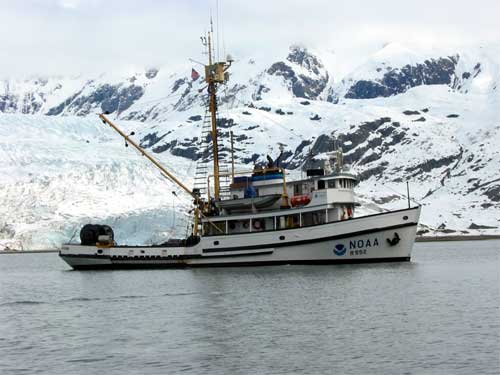 August 13, 2008
The 93-foot fisheries research vessel began service in 1950 with the Bureau of Fisheries, predecessor to NOAA's Fisheries Service, conducting albacore tuna surveys in Oregon, Washington, and Alaska. Homeported in Seattle, Cobb has operated primarily in Alaskan waters for much of her service life, most recently in support of the fisheries service's Auke Bay Laboratories in Juneau.  Photo Credit: NOAA
John N. Cobb was designed as a purse-seiner, but added capabilities enabled her to utilize almost every type of fishing method, including trawling, and long-lining. The ship has conducted various types of data acquisition and research, including juvenile salmon marine ecology, juvenile rockfish habitat assessment, sablefish tagging and telemetry, marine mammal surveys, coral and sponge benthic habitat, habitat mapping of near-shore estuaries, and oceanographic sampling and long-term coastal monitoring. NOAA is investigating use of other NOAA ships or chartered vessels to carry on Cobb's work in Alaska. Cobb's career has included some interesting and unusual missions:
The ship was named after John Nathan Cobb, an author, naturalist, and conservationist (1868-1930) whose distinguished career included service as editor of Pacific Fisherman and founding director of the College of Fisheries, University of Washingtonthe first fisheries school in the United States. John N. Cobb's post-NOAA home has yet to be determined. Preliminary plans are underway by maritime heritage interests to preserve Cobb as an historic representation of a federal wooden-hull fisheries research vessel and open her to the public as part of an education-outreach program. As part of the fleet of NOAA research and survey ships and vessels, John N. Cobb has been operated, managed and maintained by officers of the NOAA Corps and civilians under NOAA's Office of Marine and Aviation Operations. Her last commanding officer was Lt. Chad Cary, NOAA, a native of Juneau, Alaska. Source of News:
Publish A Letter in SitNews Read Letters/Opinions
|